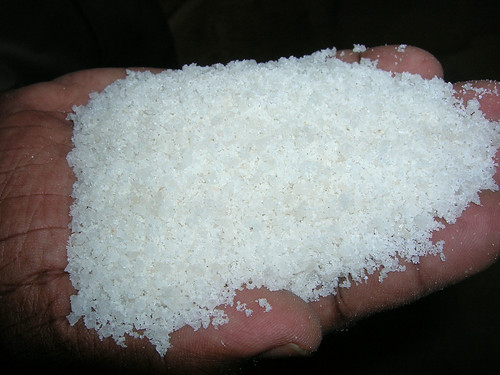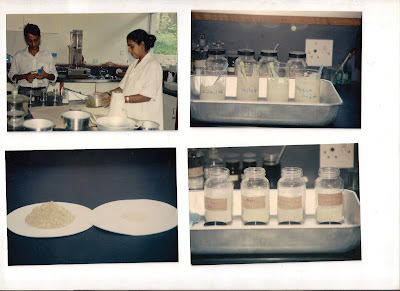
නීරක්තිය, ශ්රී ලංකාවේ පෝෂණ ක්ෂේත්රයේ තවමත් විසඳුමක් නොමැති දැවෙන ප්රශ්නයක් ලෙස පවතිනවා.
සමස්ථයක් ලෙස ගත් විට නීරක්තිය ජනගහනයෙන් 20-40% දක්වා ප්රමාණයකට පවතිනවා. මෙම තත්වය වතු ආශ්රිත ජනයා අතරත් කුඩා දරුවන් අතරත් බහුලයි.තේ වගා කෙරෙන සමහර දිස්ත්රික්ක වල කුඩා ලමුන් අතර නීරක්තිය 40% වැනි ඉහල අගයයන් පවා වාර්තා වී තිබෙනවා.මෙයට එක් හේතුවක් ලෙස එම ප්රදේශ වල බහුලව පවතින පණු රෝග හේතු වන බව කිව හැකියි.
නීරක්තිය නිසා හුස්ම ගැනීමට මෙන්ම, ඇඟ වෙහෙසා වැඩ කිරීමේ අපහසුතා ඇති වෙනවා.මෙනිසා රටක ශ්රම බලකායේ කාර්යක්ෂමතාව අඩුවී ආර්ථිකය පරිහානියට පත්වීම සිදුවෙනවා. නීරක්තිය නිසා ගැබිනි මව්වරුන්ට අඩුබර දරුවන් ලැබීමෙන් පසු කාලීනව එම දරුවන් විවිධ බෝ නොවන රෝග වලට ලක් වෙනවා. වඩාත්ම අහිතකර ප්රතිඵලය වන්නේ වැඩෙන දරුවන් නීරක්තියට ලක්වීමෙන් ඔවුන්ගේ බුද්ධි මට්ටම හීන වීමයි ,මෙවිට දරුවාට ඉගෙනීමට ඇති තම සහජ දක්ෂතාව දැක්වීමට නොහැකි වීම සිදු වෙනවා.
සමහර රුධිරගත රෝග ආදිය හැරුණු කොට, ලංකාවේ නීරක්තියට හේතුව යකඩ ඌනතාවයයි. සියළුම ගර්භණී මව්වරුන්, කිරි දෙන මව්වරු, සමහර ප්රාථමික ශ්රේණිවල පාසැල් සිසුන් හා සියළුම නොමේරූ දරු උපත් වලට මෙන්ම යකඩ ඌනතාවය විනිශ්චය කළ සියල්ලන්ටම, යකඩ ප්රතිකාරයද, ඉහත සමහර කාණ්ඩ වලට ඊට අමතරව පණු ප්රතිකාරද, ත්රිපෝෂ ද සෞඛ්ය අංශ විසින් ලබා දෙනවා. ඉහත ක්රියාමාර්ග සියල්ලම තිබුනත් මෙතරම් ප්රතිශතයක් නීරක්තියෙන් පෙළෙන්න්නේ ඇයි? ද යන්න අප හමුවේ ඇති ගැටළුවක්.
නීරක්තිය මෙතරම් ම බහුල සෞඛ්ය ගැටළුවක් වන හෙයින් ද, එමගින් එක් එක් පුද්ගලයාට මෙන්ම රටේ ප්රගමනයට ද වන හානිය සලකා බලා ,සියල්ලන්ටම ප්රමාණවත් පරිදි දෛනික යකඩ ප්රමාණයක් ලබා දීමට පියවර ගත යුතු තත්වයක් උදා වී තිබෙනවා. මෙහිදී, එදිනෙදා ආහාරයට ගන්නා තිරිඟු පිටි හෝ ලුණු වැනි පාරිභෝගික භාණ්ඩයක් යකඩ වලින් සබලීකෘත(fortify) කිරීම ලෝකයේ බහුලව භාවිතා වන ක්රමයක් වනවා; ලාංකිකයන්ගේ තිරිඟු පිටි පරිභෝජනය අඩු කරලීමේ ක්රියාදාමයක අප නිරත වී සිටින බැවිනුත්, ලුණු අයඩින් වලින් සබලීකරණය කිරීමෙන් "අයඩින් ඌනතා ගලගණ්ඩය" තුරන් කිරීම වැනි අප ලබා ඇති සාර්ථක අත්දැකීම් ආදියත් සළකා,ලුණු යකඩ වලින් සබලීකෘත කිරීම ශ්රී ලංකාවට උචිත ක්රියාමාර්ගයක් ලෙස තෝරගන්නා ලදී.
මේ අනුව ලුණු දැනටමත් සිදු කෙරෙන පරිදි "අයඩින්" වලින්ද, අලුතෙන් "යකඩ" වලින්ද, "ද්විත්ව සබලීකරණයකට" ලක් වෙනවා. දැනට මෙසේ ලුණු වලට යකඩ එක් කල හැකි යන්ත්ර හම්බන්තොට ලුණු ලේවායේ පවතිනවා.
මෙම ලුණු "ද්විත්ව සබලීකරණය" හඳුවාදීමට පෙර, පූර්ව පර්යේෂණ කටයුතු දැනට අප ආයතනය මගින් ගම්පහ දිස්ත්රික්කයේ තෝරාගත් ප්රදේශවල සිදු කෙරෙමින් පවතිනවා. එහි ප්රතිපල නුදුරේදී ම දැන ගැනීමට හැකියි.
ලිව්වේ -වෛද්ය වේදිෂ ගන්කන්ද
උපදෙස්- වෛද්ය රේණුකා ජයතිස්ස
පින්තූර-greenstone.org

























